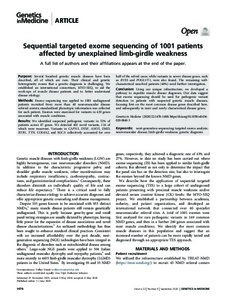Sequential targeted exome sequencing of 1001 patients affected by unexplained limb-girdle weakness
Ana Töpf; Katherine Johnson; Adam Bates; Lauren Phillips; Katherine R. Chao; Eleina M. England; Kristen M. Laricchia; Thomas Mullen; Elise Valkanas; Liwen Xu; Marta Bertoli; Alison Blain; Ana B. Casasús; Jennifer Duff; Magdalena Mroczek; Sabine Specht; Monkol Lek; Monica Ensini; Daniel G. MacArthur; MYO-SEQ consortium; Volker Straub
https://urn.fi/URN:NBN:fi-fe2021042824405
Tiivistelmä
Purpose
Several hundred genetic muscle diseases have been described, all of which are rare. Their clinical and genetic heterogeneity means that a genetic diagnosis is challenging. We established an international consortium, MYO-SEQ, to aid the work-ups of muscle disease patients and to better understand disease etiology.
Methods
Exome sequencing was applied to 1001 undiagnosed patients recruited from more than 40 neuromuscular disease referral centers; standardized phenotypic information was collected for each patient. Exomes were examined for variants in 429 genes associated with muscle conditions.
Results
We identified suspected pathogenic variants in 52% of patients across 87 genes. We detected 401 novel variants, 116 of which were recurrent. Variants in CAPN3, DYSF, ANO5, DMD, RYR1, TTN, COL6A2, and SGCA collectively accounted for over half of the solved cases; while variants in newer disease genes, such as BVES and POGLUT1, were also found. The remaining well-characterized unsolved patients (48%) need further investigation.
Conclusion
Using our unique infrastructure, we developed a pathway to expedite muscle disease diagnoses. Our data suggest that exome sequencing should be used for pathogenic variant detection in patients with suspected genetic muscle diseases, focusing first on the most common disease genes described here, and subsequently in rarer and newly characterized disease genes.
Kokoelmat
- Rinnakkaistallenteet [27094]
